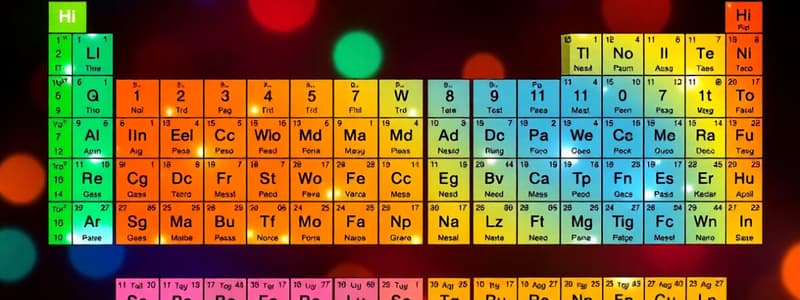Podcast
Questions and Answers
Which statement accurately describes the relationship between ion charge and the formation of ionic compounds?
Which statement accurately describes the relationship between ion charge and the formation of ionic compounds?
- Ionic compounds are formed by ions with similar electronegativity values to ensure equal charge distribution.
- Ions with the same charge form stable ionic compounds due to enhanced electrostatic attraction.
- The ratio of ions in an ionic compound is determined by balancing the total positive and negative charges to achieve electrical neutrality. (correct)
- The magnitude of the ionic charge has no bearing on the stoichiometry of the resulting compound.
How does collision theory explain the effect of temperature on reaction rate?
How does collision theory explain the effect of temperature on reaction rate?
- Increased temperature increases the average kinetic energy of molecules, leading to more frequent and energetic collisions that exceed the activation energy. (correct)
- Increased temperature decreases the frequency of collisions, lowering the probability of successful reactions.
- Increased temperature raises the activation energy required for successful collisions.
- Temperature has no effect on the collision frequency or the energy of the collisions.
Magnesium (Mg) is in Group 2 of the periodic table. What is the most likely ionic form of Magnesium and why?
Magnesium (Mg) is in Group 2 of the periodic table. What is the most likely ionic form of Magnesium and why?
- Mg-1, because it gains one electron to achieve a full outer electron shell.
- Mg-2, because it gains two electrons to achieve a full outer electron shell.
- Mg+2, because it loses two electrons to achieve a full outer electron shell. (correct)
- Mg+1, because it loses one electron to achieve a full outer electron shell.
Consider the reaction: $2H_2(g) + O_2(g) \rightarrow 2H_2O(g)$. If the rate of disappearance of $O_2$ is measured to be 0.05 M/s, what is the rate of appearance of $H_2O$?
Consider the reaction: $2H_2(g) + O_2(g) \rightarrow 2H_2O(g)$. If the rate of disappearance of $O_2$ is measured to be 0.05 M/s, what is the rate of appearance of $H_2O$?
How does a catalyst increase the rate of a chemical reaction?
How does a catalyst increase the rate of a chemical reaction?
Which of the following is NOT a typical characteristic of elements in the halogen group?
Which of the following is NOT a typical characteristic of elements in the halogen group?
In a covalent bond, what fundamental interaction holds the atoms together?
In a covalent bond, what fundamental interaction holds the atoms together?
You are monitoring a reaction that produces a gas. Which method would be most suitable for measuring the rate of this reaction?
You are monitoring a reaction that produces a gas. Which method would be most suitable for measuring the rate of this reaction?
How does increasing the concentration of reactants generally affect the rate of a chemical reaction, assuming all other factors remain constant?
How does increasing the concentration of reactants generally affect the rate of a chemical reaction, assuming all other factors remain constant?
Which group of elements is known for its inertness, rarely participating in chemical reactions?
Which group of elements is known for its inertness, rarely participating in chemical reactions?
Flashcards
Noble Gases
Noble Gases
Group 18 elements; inert due to full valence shell.
Halogens
Halogens
Group 17 elements; highly reactive nonmetals that readily gain one electron.
Alkali Metals
Alkali Metals
Group 1 elements; highly reactive metals that easily lose one electron.
Alkaline Earth Metals
Alkaline Earth Metals
Signup and view all the flashcards
Ionic Bond
Ionic Bond
Signup and view all the flashcards
Ion Ratios
Ion Ratios
Signup and view all the flashcards
Covalent Bond
Covalent Bond
Signup and view all the flashcards
Collision Theory
Collision Theory
Signup and view all the flashcards
Factors Affecting Reaction Rate
Factors Affecting Reaction Rate
Signup and view all the flashcards
Study Notes
- The periodic table features groups with distinct properties.
Noble Gases
- Located in the far right column of the periodic table.
- They are inert due to having a full valence shell.
- Generally do not form chemical bonds.
Halogens
- Situated in the second to last column on the right side of the periodic table.
- Highly reactive nonmetals.
- Readily form ions with a -1 charge.
Alkaline Metals
- Found in the first column on the left side of the periodic table (Group 1).
- Highly reactive metals.
- Tend to form ions with a +1 charge.
Alkaline Earth Metals
- Reside in the second column on the left side of the periodic table (Group 2).
- Reactive metals.
- Form ions with a +2 charge.
Ions
- Magnesium (Mg), in Group 2, forms a +2 ion, written as Mg+2.
- Ionic Bonds
- Formed through the transfer of electrons between atoms.
- Creates ions that are oppositely charged and thus attracted to each other.
- The charge of ions dictates the ratio in which they combine.
- Calcium (Ca) with a +2 charge and Fluorine (F) with a -1 charge combine to form Calcium Fluoride (CaF2).
Covalent Bonds
- Formed via the sharing of electrons between atoms.
Types of Chemical Reactions
- Reactions are categorized based on the changes occurring at the molecular level, such as synthesis, decomposition, single replacement, double replacement, and redox reactions.
Rates of Reaction
- Describe how quickly reactants are converted into products.
Collision Theory
- States that for a reaction to occur, reactant particles must collide with sufficient energy and proper orientation.
Factors Affecting Reaction Rate
- Temperature: Higher temperatures usually increase reaction rates by providing more energy for collisions.
- Concentration: Higher reactant concentrations typically increase reaction rates due to more frequent collisions.
- Surface Area: Increased surface area, especially in heterogeneous reactions, can lead to faster reaction rates.
- Catalysts: Substances that speed up reactions without being consumed by lowering the activation energy.
Measuring Reaction Rate
- Monitored by tracking the change in concentration of reactants or products over time.
- Techniques include measuring gas production, pH changes, or conductivity.
Studying That Suits You
Use AI to generate personalized quizzes and flashcards to suit your learning preferences.




